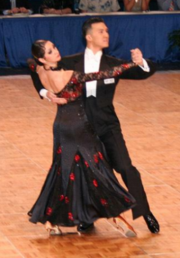Dress - Simple English Wikipedia, the free encyclopedia




A dress is one of the basic styles of female clothing. It is a garment of a skirt (bottom half) with an attached bodice (top half). The colouring and style of the dress gives the effect of a one-piece garment. A dress is also known as a frock or a gown. In Europe and the Americas, dresses are worn by females of all ages as an alternative to a separate skirt and blouse or trousers.
There are many types of dresses. A dress is usually worn at formal occasions, such as a wedding or a dance. It is also worn in the summer to keep cool. Younger females tend to prefer shorter skirts than older females.[1]
Type of dress[change | change source]
History[change | change source]
In the 11th century, women in Europe wore dresses that were like men's tunics and were loose with the hem(the very bottom cloth of a dress) below the knees or lower.
Later in the 1550s French women were inspired by Spanish-style bodices and also wore ruffs(a frilly circle worn on the neck). In England, Queen Elizabeth said what kinds of dresses women could wear.
During the 17 century, Lace and slashing(when fabric is layered and cut so it feels like velvet) became popular decorations. Skirts were full, and the overskirt(the skirt worn over all the others) allowed the display of an underskirt of contrasting fabric. Necklines became lower as well.
Skirts were wide and supported by hoop underskirts in the 18th century. One-piece gowns were popular until the middle of the century. During the 1760s in France, hoop petticoats(undergarments like skirts) were reduced in size. Women also liked lighter colors and lighter fabrics.
Women's dresses in the 19th century began to be sorted by the time of day or purpose of the dress. Dresses with high waists were popular until around 1830. Europeans styles in dresses increased quickly to the hoop skirt and the crinoline using styles of the 1860s. Dresses had "day" bodice with a high neckline and long sleeves, and an "evening" bodice with a low neckline and very short sleeves. Skirts of the 1860s had a lot of decoration.
References[change | change source]
- ↑ Davis, Michael 2007. Art of dress designing. Delhi: Global Media. ISBN 81-904575-7-8
Other websites[change | change source]
- Stylopedia -- an online dictionary of fashion details Archived 2009-09-26 at the Wayback Machine
- ApparelSeach glossary of textile and apparel terms
- An international dress size converter Archived 2007-07-07 at the Wayback Machine



 French
French Deutsch
Deutsch